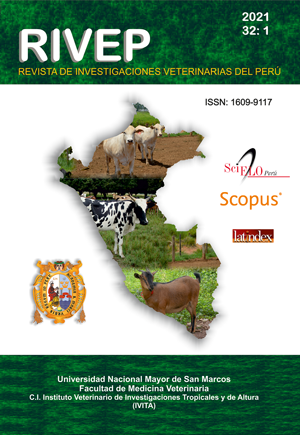Case report: Esthesioneuroblastoma in an equine
DOI:
https://doi.org/10.15381/rivep.v32i1.17340Keywords:
Esthesioneuroblastoma, Olfactory neuroblastoma, Immunohistochemistry, HistochemistryAbstract
Esthesioneuroblastoma or olfactory neuroblastoma is a malignant tumor and is derived from the olfactory neuroepithelium, rare in domestic species and particularly in equines. The present report corresponds to a 13-year-old equine patient who presented chronic respiratory disease with two years of evolution and in which period developed unilateral proptosis. At necropsy, an intracranial mass of soft consistency was found, partially delimited in the aboral region within the left nasal cavity, which extended, partially compromising the bones, presphenoids, ethmoids and membranous structures in the ethmoidal and orbital region, causing the partial protrusion of the eyeball and face compression of the left cerebral hemisphere, secondary lesions in the maxillary tuberosity, pterygopalatine fossa and guttural pouch. The microscopic findings corresponded to a neoplastic process of neuroendocrine origin, whose cells are arranged in supported nests and separated by a fine fibrovascular stroma. The neoplastic process was confirmed by immunohistochemical (IHC) and histochemical (HQ) methods, where the tumor cells were positively marked by antibodies against synaptophysin, S-100 protein antigen, neurospecific enolase (NSE) and chromogranin A. Stained Grimelius argyrophil-argentaphin cells were identified. Based on the macroscopic and microscopic findings and the use of IHQ and HQ, the presence of esthesioneuroblastoma was established.
Downloads
Downloads
Published
Issue
Section
License
Copyright (c) 2021 Ricardo Javier Piñeros, Carlos Adolfo Salazar Latorre, Carlos Alberto Venegas Cortes, Jessika Paola Galindo Rodriguez, Marie-Odile Benoit-Biancamano

This work is licensed under a Creative Commons Attribution-NonCommercial-ShareAlike 4.0 International License.
AUTHORS RETAIN THEIR RIGHTS:
a. Authors retain their trade mark rights and patent, and also on any process or procedure described in the article.
b. Authors retain their right to share, copy, distribute, perform and publicly communicate their article (eg, to place their article in an institutional repository or publish it in a book), with an acknowledgment of its initial publication in the Revista de Investigaciones Veterinarias del Perú (RIVEP).
c. Authors retain theirs right to make a subsequent publication of their work, to use the article or any part thereof (eg a compilation of his papers, lecture notes, thesis, or a book), always indicating the source of publication (the originator of the work, journal, volume, number and date).










